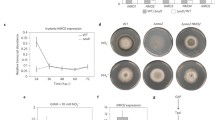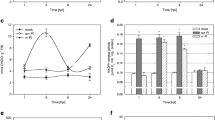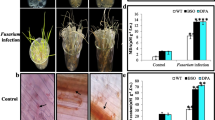Abstract
Main conclusion
ΔClnps6 induced iron redistribution in maize B73 leaf cells and resulted in reactive oxygen species (ROS) burst to enhance plant resistance against Curvularia lunata.
Abstract
Iron is an indispensable co-factor of various crucial enzymes that are involved in cellular metabolic processes and energy metabolism in eukaryotes. For this reason, plants and pathogens compete for iron to maintain their iron homeostasis, respectively. In our previous study, ΔClnps6, the extracellular siderophore biosynthesis deletion mutant of Curvularia lunata, was sensitive to exogenous hydrogen peroxide and virulence reduction. However, the mechanism was not studied. Here, we report that maize B73 displayed highly resistance to ΔClnps6. The plants recruited more iron at cell wall appositions (CWAs) to cause ROS bursts. Intracellular iron deficiency induced by iron redistribution originated form up-regulated expression of genes involved in intracellular iron consumption in leaves and absorption in roots. The RNA-sequencing data also showed that the expression of respiratory burst oxidase homologue (ZmRBOH4) and NADP-dependent malic enzyme 4 (ZmNADP-ME4) involved in ROS production was up-regulated in maize B73 after ΔClnps6 infection. Simultaneously, jasmonic acid (JA) biosynthesis genes lipoxygenase (ZmLOX), allene oxide synthase (ZmAOS), GA degradation gene gibberellin 2-beta-dioxygenase (ZmGA2OX6) and ABA degradation genes abscisic acid hydroxylase (ZmABH1, ZmABH2) involved in iron homeostasis were up-regulated expression. Ferritin1 (ZmFER1) positive regulated maize resistance against C. lunata via ROS burst under Fe-limiting conditions. Overall, our results showed that iron played vital roles in activating maize resistance in B73-C. lunata interaction.








Similar content being viewed by others
Data availability
All data, models, and code generated or used during the study appear in the submitted article.
Abbreviations
- AOS:
-
Allene oxide synthase
- BTS:
-
E3 ligase BRUTUS
- CWAs:
-
Cell wall appositions
- DAB:
-
3,3-Diaminobenzidine
- DCF:
-
CM-H2DCFDA
- DPI:
-
Diphenyleneiodonium chloride
- FER1:
-
Ferritin1
- hpi:
-
Hours post inoculation
- JA:
-
Jasmonic acid
- LOX:
-
Lipoxygenase
- RBOH4:
-
Respiratory burst oxidase homologue
References
Albarouki E, Deising HB (2013) Infection structure-specific reductive iron assimilation is required for cell wall integrity and full virulence of the maize pathogen Colletotrichum graminicola. Mol Plant Microbe Interact 26(6):695–708. https://doi.org/10.1094/mpmi-01-13-0003-r
Albert M, Butenko M, Aalen R, Felix G, Wildhagen M (2015) Chemiluminescence detection of the oxidative burst in plant leaf pieces. Bio-Protoc 5(6):e1423. https://doi.org/10.21769/BioProtoc.1423
Aznar A, Chen NWG, Rigault M, Riache N, Joseph D, Desmaële D, Mouille G, Boutet S, Soubigou-Taconnat L, Renou J-P, Thomine S, Expert D, Dellagi A (2014a) Scavenging iron: a novel mechanism of plant immunity activation by microbial siderophores. Plant Physiol 164(4):2167–2183. https://doi.org/10.1104/pp.113.233585
Aznar A, Patrit O, Berger A, Dellagi A (2014b) Alterations of iron distribution in Arabidopsis tissues infected by Dickeya dadantii. Mol Plant Pathol 16(5):521–528. https://doi.org/10.1111/mpp.12208
Aznar A, Chen NW, Thomine S, Dellagi A (2015) Immunity to plant pathogens and iron homeostasis. Plant Sci 240:90–97. https://doi.org/10.1016/j.plantsci.2015.08.022
Bashir K, Inoue H, Nagasaka S, Takahashi M, Nakanishi H, Mori S, Nishizawa NK (2006) Cloning and characterization of deoxymugineic acid synthase genes from graminaceous plants. J Biol Chem 281(43):32395–32402. https://doi.org/10.1074/jbc.M604133200
Boughammoura A, Franza T, Dellagi A, Roux C, Matzanke-Markstein B, Expert D (2007) Ferritins, bacterial virulence and plant defence. Biometals 20(3–4):347–353. https://doi.org/10.1007/s10534-006-9069-0
Briat JF, Ravet K, Arnaud N, Duc C, Boucherez J, Touraine B, Cellier F, Gaymard F (2010) New insights into ferritin synthesis and function highlight a link between iron homeostasis and oxidative stress in plants. Ann Bot 105(5):811–822. https://doi.org/10.1093/aob/mcp128
Christensen SA, Huffaker A, Kaplan F, Sims J, Ziemann S, Doehlemann G, Ji L, Schmitz RJ, Kolomiets MV, Alborn HT, Mori N, Jander G, Ni X, Sartor RC, Byers S, Abdo Z, Schmelz EA (2015) Maize death acids, 9-lipoxygenase-derived cyclopente(a)nones, display activity as cytotoxic phytoalexins and transcriptional mediators. Proc Natl Acad Sci USA 112(36):11407–11412. https://doi.org/10.1073/pnas.1511131112
Cui Y, Chen CL, Cui M, Zhou WJ, Wu HL, Ling HQ (2018) Four IVa bHLH transcription factors are novel interactors of FIT and mediate JA inhibition of iron uptake in Arabidopsis. Mol Plant 11(9):1166–1183. https://doi.org/10.1016/j.molp.2018.06.005
Curie C, Panaviene Z, Loulergue C, Dellaporta SL, Briat JF, Walker EL (2001) Maize yellow stripe1 encodes a membrane protein directly involved in Fe(III) uptake. Nature 409(6818):346–349. https://doi.org/10.1038/35053080
Dangol S, Chen Y, Hwang BK, Jwa NS (2019) Iron- and reactive oxygen species-dependent ferroptotic cell death in rice-Magnaporthe oryzae interactions. Plant Cell 31(1):189–209. https://doi.org/10.1105/tpc.18.00535
Danon A, Miersch O, Felix G, Camp RG, Apel K (2005) Concurrent activation of cell death-regulating signaling pathways by singlet oxygen in Arabidopsis thaliana. Plant J 41(1):68–80. https://doi.org/10.1111/j.1365-313X.2004.02276.x
Dellagi A, Rigault M, Segond D, Roux C, Kraepiel Y, Cellier F, Briat JF, Gaymard F, Expert D (2005) Siderophore-mediated upregulation of Arabidopsis ferritin expression in response to Erwinia chrysanthemi infection. Plant J 43(2):262–272. https://doi.org/10.1111/j.1365-313X.2005.02451.x
Eichhorn H, Lessing F, Winterberg B, Schirawski J, Jr K, Müller P, Kahmann R (2006) A ferroxidation/permeation iron uptake system is required for virulence in Ustilago maydis. Plant Cell 18(11):3332–3345. https://doi.org/10.1105/tpc.106.043588
Eide D, Broderius M, Fett J, Guerinot ML (1996) A novel iron-regulated metal transporter from plants identified by functional expression in yeast. Proc Natl Acad Sci USA 93(11):5624–5628. https://doi.org/10.1073/pnas.93.11.5624
Gao F, Robe K, Bettembourg M, Navarro N, Rofidal V, Santoni V, Gaymard F, Vignols F, Roschzttardtz H, Izquierdo E, Dubos C (2020) The transcription factor bHLH121 interacts with bHLH105 (ILR3) and its closest homologs to regulate iron homeostasis in Arabidopsis. Plant Cell 32(2):508–524. https://doi.org/10.1105/tpc.19.00541
Golonka R, Yeoh BS, Vijay-Kumar M (2019) The iron tug-of-war between bacterial siderophores and innate immunity. J Innate Immun 11(3):249–262. https://doi.org/10.1159/000494627
Inoue H, Kobayashi T, Nozoye T, Takahashi M, Kakei Y, Suzuki K, Nakazono M, Nakanishi H, Mori S, Nishizawa NK (2009) Rice OsYSL15 is an iron-regulated iron(III)-deoxymugineic acid transporter expressed in the roots and is essential for iron uptake in early growth of the seedlings. J Biol Chem 284(6):3470–3479. https://doi.org/10.1074/jbc.M806042200
Kieu NP, Aznar A, Segond D, Rigault M, Simond-Cote E, Kunz C, Soulie MC, Expert D, Dellagi A (2012) Iron deficiency affects plant defence responses and confers resistance to Dickeya dadantii and Botrytis cinerea. Mol Plant Pathol 13(8):816–827. https://doi.org/10.1111/j.1364-3703.2012.00790.x
Kim SA, Punshon T, Lanzirotti A, Li L, Alonso JM, Ecker JR, Kaplan J, Guerinot ML (2006) Localization of iron in Arabidopsis seed requires the vacuolar membrane transporter VIT1. Science 314(5803):1295–1298. https://doi.org/10.1126/science.1132563
Kim SA, LaCroix IS, Gerber SA, Guerinot ML (2019) The iron deficiency response in Arabidopsis thaliana requires the phosphorylated transcription factor URI. Proc Natl Acad Sci USA 116(50):24933–24942. https://doi.org/10.1073/pnas.1916892116
Kobayashi T, Itai RN, Senoura T, Oikawa T, Ishimaru Y, Ueda M, Nakanishi H, Nishizawa NK (2016) Jasmonate signaling is activated in the very early stages of iron deficiency responses in rice roots. Plant Mol Biol 91(4–5):533–547. https://doi.org/10.1007/s11103-016-0486-3
Lanquar V, Lelièvre F, Bolte S, Hamès C, AlconC ND, Vansuyt G, Curie C, Schröder A, Krämer U, Barbier-Brygoo H, Thomine S (2005) Mobilization of vacuolar iron by AtNRAMP3 and AtNRAMP4 is essential for seed germination on low iron. EMBO J 24(23):4041–4051. https://doi.org/10.1038/sj.emboj.7600864
Le Jean M, Schikora A, Mari S, Briat JF, Curie C (2005) A loss-of-function mutation in AtYSL1 reveals its role in iron and nicotianamine seed loading. Plant J 44(5):769–782. https://doi.org/10.1111/j.1365-313X.2005.02569.x
Lee S, Chiecko JC, Kim SA, Walker EL, Lee Y, Guerinot ML, An G (2009) Disruption of OsYSL15 leads to iron inefficiency in rice plants. Plant Physiol 150(2):786–800. https://doi.org/10.1104/pp.109.135418
Li X, Zhang H, Ai Q, Liang G, Yu D (2016) Two bHLH transcription factors, bHLH34 and bHLH104, regulate iron homeostasis in Arabidopsis thaliana. Plant Physiol 170(4):2478–2493. https://doi.org/10.1104/pp.15.01827
Li Y, Lu CK, Li CY, Lei RH, Pu MN, Zhao JH, Peng F, Ping HQ, Wang D, Liang G (2021) IRON MAN interacts with BRUTUS to maintain iron homeostasis in Arabidopsis. Proc Natl Acad Sci USA. https://doi.org/10.1073/pnas.2109063118
Liang G, Zhang H, Li X, Ai Q, Yu D (2017) bHLH transcription factor bHLH115 regulates iron homeostasis in Arabidopsis thaliana. J Exp Bot 68(7):1743–1755. https://doi.org/10.1093/jxb/erx043
Lingam S, Mohrbacher J, Brumbarova T, Potuschak T, Fink-Straube C, Blondet E, Genschik P, Bauer P (2011) Interaction between the bHLH transcription factor FIT and ETHYLENE INSENSITIVE3/ETHYLENE INSENSITIVE3-LIKE1 reveals molecular linkage between the regulation of iron acquisition and ethylene signaling in Arabidopsis. Plant Cell 23(5):1815–1829. https://doi.org/10.1105/tpc.111.084715
Liu G, Greenshields DL, Sammynaiken R, Hirji RN, Selvaraj G, Wei Y (2007) Targeted alterations in iron homeostasis underlie plant defense responses. J Cell Sci 120(Pt4):596–605. https://doi.org/10.1242/jcs.001362
Livak KJ, Schmittgen TD (2001) Analysis of relative gene expression data using real-time quantitative PCR and the 2−ΔΔCT method. Methods 25(4):402–408. https://doi.org/10.1006/meth.2001.1262
Long TA, Tsukagoshi H, Busch W, Lahner B, Salt DE, Benfey PN (2010) The bHLH transcription factor POPEYE regulates response to iron deficiency in Arabidopsis roots. Plant Cell 22(7):2219–2236. https://doi.org/10.1105/tpc.110.074096
Lu X, Liu J, Ren W, Yang Q, Chai Z, Chen R, Wang L, Zhao J, Lang Z, Wang H, Fan Y, Zhao J, Zhang C (2018) Gene-indexed mutations in maize. Mol Plant 11(3):496–504. https://doi.org/10.1016/j.molp.2017.11.013
Lu YY, Sun JY, Gao YB, Liu KX, Yuan MY, Gao WD, Wang F, Fu DD, Chen N, Xiao SQ, Xue CS (2021) The key iron assimilation genes ClFTR1, ClNPS6 were crucial for virulence of Curvularia lunatavia initiating its appressorium formation and virulence factors. Environ Microbiol 23(2):613–627. https://doi.org/10.1111/1462-2920.15101
Matsuoka K, Furukawa J, Bidadi H, Asahina M, Yamaguchi S, Satoh S (2014) Gibberellin-induced expression of Fe uptake-related genes in Arabidopsis. Plant Cell Physiol 55(1):87–98. https://doi.org/10.1093/pcp/pct160
Motta A, Basso B, Dell’Orto M, Briat J-F, Soave C (2001) Ferritin synthesis in response to iron in the Fe-inefficient maize mutant ys3. Plant Physiol Biochem 39(6):461–465. https://doi.org/10.1016/S0981-9428(01)01269-4
Murata Y, Ma JF, Yamaji N, Ueno D, Nomoto K, Iwashita T (2006) A specific transporter for iron(III)-phytosiderophore in barley roots. Plant J 46(4):563–572. https://doi.org/10.1111/j.1365-313X.2006.02714.x
Oide S, Moeder W, Krasnoff S, Gibson D, Haas H, Yoshioka K, Turgeon BG (2006) NPS6, encoding a nonribosomal peptide synthetase involved in siderophore-mediated iron metabolism, is a conserved virulence determinant of plant pathogenic Ascomycetes. Plant Cell 18(10):2836–2853. https://doi.org/10.1105/tpc.106.045633
Park SW, Li W, Viehhauser A, He B, Kim S, Nilsson AK, Andersson MX, Kittle JD, Ambavaram MM, Luan S, Esker AR, Tholl D, Cimini D, Ellerstrom M, Coaker G, Mitchell TK, Pereira A, Dietz KJ, Lawrence CB (2013) Cyclophilin 20–3 relays a 12-oxo-phytodienoic acid signal during stress responsive regulation of cellular redox homeostasis. Proc Natl Acad Sci USA 110(23):9559–9564. https://doi.org/10.1073/pnas.1218872110
Ravet K, Touraine B, Boucherez J, Briat JF, Gaymard F, Cellier F (2009) Ferritins control interaction between iron homeostasis and oxidative stress in Arabidopsis. Plant J 57(3):400–412. https://doi.org/10.1111/j.1365-313X.2008.03698.x
Renshaw JC, Robson GD, Trinci APJ, Wiebe MG, Livens FR, Collison D, Taylor RJ (2002) Fungal siderophores: structures, functions and applications. Mycol Res 106(10):1123–1142. https://doi.org/10.1017/S0953756202006548
Robinson NJ, Procter CM, Connolly EL, Guerinot ML (1999) A ferric-chelate reductase for iron uptake from soils. Nature 397(6721):694–697. https://doi.org/10.1038/17800
Römheld V (1987) Different strategies for iron acquisition in higher plants. Physiol Plant 70(2):231–234. https://doi.org/10.1111/j.1399-3054.1987.tb06137.x
Romheld V, Marschner H (1986) Evidence for a specific uptake system for iron phytosiderophores in roots of grasses. Plant Physiol 80(1):175–180. https://doi.org/10.1104/pp.80.1.175
Santi S, Schmidt W (2009) Dissecting iron deficiency-induced proton extrusion in Arabidopsis roots. New Phytol 183(4):1072–1084. https://doi.org/10.1111/j.1469-8137.2009.02908.x
Schaible UE, Kaufmann SH (2004) Iron and microbial infection. Nat Rev Microbiol 2(12):946–953. https://doi.org/10.1038/nrmicro1046
Schwyn B, Neilands JB (1987) Siderophores from agronomically important species of Rhizobiaceae. Comments Agric Food Chem 1:95–114
Theil EC (1987) Ferritin: structure, gene regulation, and cellular function in animals, plants, and microorganisms. Annu Rev Biochem 56:289–315. https://doi.org/10.1146/annurev.bi.56.070187.001445
Trapet PL, Verbon EH, Bosma RR, Voordendag K, Van Pelt JA, Pieterse CMJ (2021) Mechanisms underlying iron deficiency-induced resistance against pathogens with different lifestyles. J Exp Bot 72(6):2231–2241. https://doi.org/10.1093/jxb/eraa535
Verbon EH, Trapet PL, Stringlis IA, Kruijs S, Bakker P, Pieterse CMJ (2017) Iron and immunity. Annu Rev Phytopathol 55(1):355–375. https://doi.org/10.1146/annurev-phyto-080516-035537
Wang H, Hou J, Ye P, Hu L, Huang J, Dai Z, Zhang B, Dai S, Que J, Min H, Chen G, Wang Y, Jiang M, Liang Y, Li L, Zhang X, Lai Z (2021) A teosinte-derived allele of a MYB transcription repressor confers multiple disease resistance in maize. Mol Plant 14(11):1846–1863. https://doi.org/10.1016/j.molp.2021.07.008
Weinberg ED (1975) Nutritional immunity: Host’s attempt to withold iron from microbial invaders. JAMA 231(1):39–41. https://doi.org/10.1001/jama.231.1.39
Xing Y, Xu N, Bhandari DD, Lapin D, Sun X, Luo X, Wang Y, Cao J, Wang H, Coaker G, Parker JE, Liu J (2021) Bacterial effector targeting of a plant iron sensor facilitates iron acquisition and pathogen colonization. Plant Cell 33(6):2015–2031. https://doi.org/10.1093/plcell/koab075
Ye F, Albarouki E, Lingam B, Deising HB, von Wiren N (2014) An adequate Fe nutritional status of maize suppresses infection and biotrophic growth of Colletotrichum graminicola. Physiol Plant 151(3):280–292. https://doi.org/10.1111/ppl.12166
Zhai Z, Gayomba SR, Jung H-i, Vimalakumari NK, Piñeros M, Craft E, Rutzke MA, Danku J, Lahner B, Punshon T, Guerinot ML, Salt DE, Kochian LV, Vatamaniuk OK (2014) OPT3 is a phloem-specific iron transporter that is essential for systemic iron signaling and redistribution of iron and cadmium in Arabidopsis. Plant Cell 26(5):2249–2264. https://doi.org/10.1105/tpc.114.123737
Zhang XY, Qiu JY, Hui QL, Xu YY, He YZ, Peng LZ, Fu XZ (2020) Systematic analysis of the basic/helix-loop-helix (bHLH) transcription factor family in pummelo (Citrus grandis) and identification of the key members involved in the response to iron deficiency. BMC Genomics 21(1):233. https://doi.org/10.1186/s12864-020-6644-7
Acknowledgements
This study was funded by the National Natural Science Foundation of China (Grant No. 31271992). We thank Prof. Junbo Luan (College of Plant Protection, Shenyang Agricultural University), Prof. Xiaofeng Zhu (College of Plant Protection, Shenyang Agricultural University), Prof. Xiaori Han (College of Land and Environment, Shenyang Agricultural University) for instruments support. We would like to thank Plant Bio Press Editing (http://www.plantbiopressediting.com/) for its linguistic assistance during the preparation of this manuscript.
Author information
Authors and Affiliations
Corresponding authors
Ethics declarations
Conflict of interest
The authors declare no conflict of interest.
Additional information
Communicated by Dorothea Bartels.
Publisher's Note
Springer Nature remains neutral with regard to jurisdictional claims in published maps and institutional affiliations.
Supplementary Information
Below is the link to the electronic supplementary material.
425_2022_3963_MOESM7_ESM.pdf
Supplementary Fig. S1 Extracellular siderophore biosynthesis analysis of ΔClnps6 and CX-3. a Extracellular siderophore detection on chromeazurol S (CAS) media. The orange halo on CAS media of ΔClnps6 was smaller than that of CX-3, indicating that there was less extracellular siderophore in ΔClnps6. b ΔClnps6 and CX-3 were incubated in MM-Fe media. c HPLC analysis of MM-Fe broth. Extracellular siderophore was extracted and analyzed by HPLC as previously described by Oide et al. (2006). HPLC analysis of each sample of the same proportion of the total extract with a 50 μL aliquot. (PDF 1554 kb)
425_2022_3963_MOESM8_ESM.pdf
Supplementary Fig. S2 Iron accumulation and ROS burst in onion epidermis caused by ΔClnps6 and CX-3. a The accumulation of ferric iron (Fe3+) in onion epidermal cells inoculated by ΔClnps6. b Iron chelator deferoxamine (DFO, 1 mM) was used as control. c H2O2 accumulation in inoculated epidermal cells significantly increased after ΔClnps6 treatment at 24 hpi. (PDF 5948 kb)
425_2022_3963_MOESM9_ESM.pdf
Supplementary Fig. S3 Differentially expressed genes (DEGs) in maize leaves inoculated by ΔClnps6 and CX-3. a, b Venn diagram of co-expression genes in maize leaves inoculated by ΔClnps6 and CX-3 at 6, 24, 48 hpi. c, d The most enriched GO of up-regulated and down-regulated expression in maize leaves inoculated by ΔClnps6 and CX-3. DEGs were filtered with a cut off of log2-fold change ≥ 1 and FDR-corrected P ≤ 0.01. (PDF 2081 kb)
425_2022_3963_MOESM10_ESM.pdf
Supplementary Fig. S4 The most enriched KEGG pathways of up-regulated and down-regulated expression in maize leaves inoculated by ΔClnps6 and CX-3. a-c The up-regulated expression of genes at 6 hpi were mostly associated with glycolysis/gluconeogenesis and oxidative phosphorylation pathway, at 24 hpi with ribosome and protein processing in endoplasmic reticulum pathway, at 48 hpi with plant-pathogen interaction and plant hormone signal transduction pathway. d-f The down-regulated expression of genes at 6 hpi were mainly associated with glycerophospholipid metabolism and plant-pathogen interaction, at 24 hpi with glutathione metabolism, phenylpropanoid biosynthesis and phenylalanine pathway, and at 48 hpi with monoterpenoid biosynthesis and phenylpropanoid biosynthesis pathway. “Rich factor” indicates the ratio of the DEGs number vs the number of genes annotated in this pathway. (PDF 2394 kb)
Rights and permissions
About this article
Cite this article
Fu, D., Li, J., Yang, X. et al. Iron redistribution induces oxidative burst and resistance in maize against Curvularia lunata. Planta 256, 46 (2022). https://doi.org/10.1007/s00425-022-03963-7
Received:
Accepted:
Published:
DOI: https://doi.org/10.1007/s00425-022-03963-7




